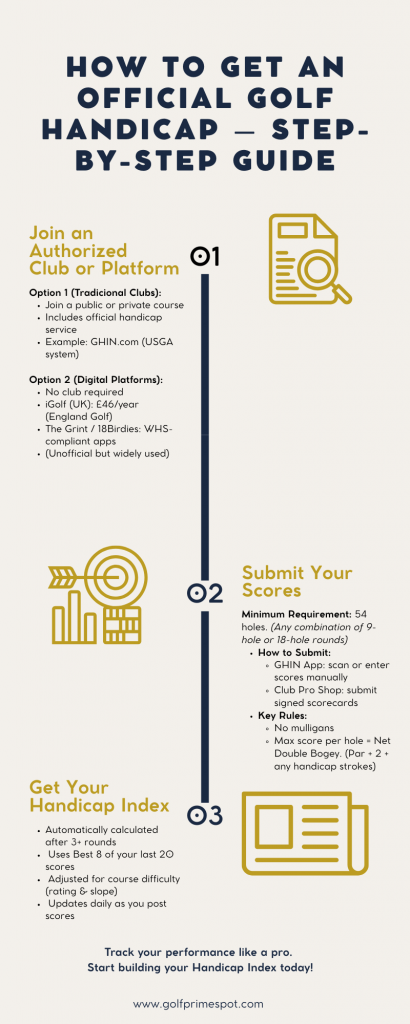What Is a Golf Handicap? The Great Equalizer
A golf handicap is a numerical measure of a player’s skill level, designed to level the playing field so competitors of all abilities can enjoy fair matches. Think of it as golf’s version of a “weight adjustment” in horse racing—it answers:
- “How many strokes over/under par can this player typically shoot?”
- “How do we adjust scores when a 25-handicapper faces a scratch golfer?”
Key Characteristics
Lower number = Better player (e.g., a 5-handicap is stronger than a 20-handicap).
Dynamic: Updates with each new round submitted (via systems like GHIN or WHS).
Global standard: Governed by the World Handicap System (WHS) since 2020.
How It Works: A Real-World Example
- A 20-handicap player gets 20 extra strokes vs. a 0-handicap (scratch golfer).
- On a par-72 course:
- Gross score: 92
- Minus handicap: 20
- Net score: 72 (par)!
Pro Tip:
Your handicap index reflects your potential ability, not your average score. According to the USGA, it’s calculated from your best 8 rounds out of 20—meaning even a 15-handicap can shoot close to par on a great day!”
— USGA Handicap System Explained
Golf Handicap Basics: What It Is & Why It Matters
A golf handicap is a number that represents your skill level. It lets players of different abilities compete fairly by adjusting scores.
- Lower handicap = Better player (e.g., a 5-handicap is stronger than a 20-handicap).
- Not your average score: It’s based on your potential (your best rounds, not all rounds).
Example:
If your handicap is 10, you typically shoot 10 strokes over par. On a par-72 course:
- Gross score: 82
- Net score: 72 (par) after subtracting your handicap.
Why Use a Handicap?
- Fair Play: A 25-handicap can compete against a 5-handicap by getting extra strokes.
- Track Progress: As you improve, your handicap drops.
- Play Anywhere: Recognized globally (via the World Handicap System).
Reddit User Explains:
“It’s like a golf equalizer. My dad (20 HCP) beats me (5 HCP) sometimes because of it!” — u/UnscrewedLid
Key Takeaways (No Jargon!)
- It’s a skill meter – Lower number = better player.
- It makes games fair – Adjusts scores so anyone can compete.
- It rewards consistency – Based on your best rounds, not all rounds.
Common Questions Answered
“Is a 10-handicap good?”
→ Yes! It means you typically shoot 10 over par, better than most casual golfers.
“Do I need one?”
→ Only if you want to play in tournaments or compete fairly with friends.
What’s Next?
Now that you know what a handicap is, let’s break down how to calculate yours → [Link to Point 2].
How Is a Golf Handicap Calculated? (Simple Explanation)
Your golf handicap is calculated using your best 8 scores from your last 20 rounds, adjusted for course difficulty. It’s not your average score—it’s your potential ability.
Key Terms Explained:
- Handicap Index® (Official Measure):
- A number (e.g., 12.5) representing your skill level under the World Handicap System (WHS).
- Calculated by:
- Score Differential = (Your Adjusted Score − Course Rating) × (113 / Slope Rating).
- Average your 8 best differentials from 20 rounds.
- Course Rating:
- The expected score for a scratch golfer (e.g., 72.5 on a par-72 course).
- Slope Rating:
- Measures how much harder the course is for an average golfer vs. a scratch golfer (range: 55–155; 113 = average).
Step-by-Step Golf Handicap Calculation Explained
- Adjust Your Gross Score:
- Cap each hole at net double bogey (par + 2 + handicap strokes).
- Example: On a par-4 with 1 handicap stroke, max score = 4 + 2 + 1 = 7.
- Calculate Score Differentials:
- For each round:
Differential = (Adjusted Score − Course Rating) × (113 / Slope Rating)
Example: Shoot 85 on a course rated 72.5 (Slope 125):
(85 − 72.5) × (113 / 125) = **11.3**
- Average Your Best 8 Differentials:
- If you’ve played 20+ rounds, use the lowest 8. Fewer rounds? See table below.
- Get Your Handicap Index:
- Multiply the average by 0.96 (WHS “bonus for excellence”).
- Example: Average of 8 best differentials = 10.4 → 10.0 (10.4 × 0.96).
Fewer Than 20 Rounds?
| Rounds Played | Differentials Used | Adjustment |
| 3 – 6 | Lowest 1 | -2.0 |
| 7 – 8 | Lowest 2 | -1.0 |
| 9 – 11 | Lowest 3 | None |
Tools Tools to Skip the Math
- USGA/GHIN Calculator: Enter scores online; it auto-calculates your Index (GHIN.com).
- Golf Apps: Like The Grint or 18Birdies track handicaps for you.
Why It Works This Way
- Fairness: Uses your best rounds to reflect potential, not inconsistency.
- Adaptability: Adjusts for course difficulty (e.g., a 10-handicap might be 8 on an easy course, 12 on a hard one).
Reddit User Explains:
“It’s not your average—it’s what you’re capable of on a good day. That’s why you’ll only shoot your handicap ~25% of the time.” — u/movtga
Key Takeaways
- Your handicap is based on potential, not average scores.
- Net double bogey limits blow-up holes.
- Slope Rating levels the field between courses.
- Use apps or GHIN to avoid manual math.
How to Get an Official Golf Handicap: A Step-by-Step Guide
What Is a Handicap Index?
A Handicap Index® is your official golf skill rating under the World Handicap System (WHS). It’s a number (e.g., 12.5) that:
- Levels the playing field (lets you compete fairly with anyone).
- Tracks your progress (lowers as you improve).
- Is recognized globally (used in 80+ countries).
USGA Explains It Best:
“Think of it as your golf résumé—it shows your potential, not just your average score.”
How to Get Your Handicap Index
A Simple 3-Step Guide for Beginners
Follow these 3 easy steps to calculate your Handicap Index with confidence.

Pro Tip:
“Your first Index might be high—don’t stress! It’ll drop as you submit more scores.” — Golf Monthly
GHIN vs. iGolf vs. The Grint
| Option | Cost | Best For | Official? |
| GHIN (USGA) | ~40–40–100/year | Club members; tournament play | ✅ Yes |
| iGolf (UK) | £46/year | Non-club members | ✅ Yes |
| The Grint | Free/$40/year | Casual tracking | ❌ No* |
*Some apps comply with WHS but aren’t accepted for official events.
How to Get a Golf Handicap FAQ´s
“Can I get a handicap without joining a club?”
→ Yes! Use iGolf (UK) or The Grint (US).
“How often does my Index update?”
→ Daily (WHS) or monthly (some clubs).
“What’s the max handicap?”
→ 54.0 for men/women under WHS.
Key Takeaways
- Join GHIN/iGolf or a local club.
- Submit 54+ holes (mix 9/18-hole rounds).
- Net double bogey limits blow-up holes.
- Use apps to auto-calculate your Index.
Sources:
¿What is a Good Golf Handicap? (Averages & Skill Levels)
A “good” handicap depends on perspective, but here’s the data:
- Average Handicap: ~16 (men), ~28 (women) (USGA/WHS, 2024).
- Mid-Handicap: 11–20 (breaks 90 consistently).
- Single-Digit (≤9): Top 25% of male golfers.
Handicap Tiers Explained
| Range | Skill Level | Score (Par 72) | % of Golfers | Source |
| Scratch to +4 | Elite | ≤72 | <1% | USGA Elite Player Reports |
| 0–9 | Low (Single-Digit) | 73–81 | ~12% (Men) | USGA 2024 Percentiles |
| 10–20 | Mid-Recreational | 82–92 | ~45% (Men) | Golf Monthly Analysis |
| 21–30 | High (Social) | 93–102 | ~30% (Men) | England Golf iGolf |
| 30+ | Beginner | 103+ | ~12% (Men) | USGA |
Key Stats:
- Most common range: 10–15 for men, 25–30 for women (USGA, Golf Monthly).
- Only 0.07% of men and 4.1% of women hold the max handicap of 54 (USGA).
What Defines a “Good” Golfer?
- By the Numbers (Official Data):
- ≤9 Handicap: Top 12% of male golfers (USGA).
- 10–15: “Better than average” (breaks 90 regularly, Golf Monthly).
- By Peer Perception (Reddit Surveys):
- Non-golfers: Consider a 15-handicap “pro level” (Reddit thread: “At what handicap do you consider a player good?”).
- Casual golfers: 61% voted ≤10 as “good” (The Hacker’s Paradise survey, 2023).
- Low-handicappers: 72% said ≤5 is truly skilled (Reddit poll, 1.2k votes).
“I’m a 5-handicap. My family thinks I’m Tiger Woods. My golf buddies say I’m trash.”
— u/ComfortablePlane8936 (Reddit, 2023)
Gender Differences
- Women’s average handicap is higher (28) due to:
- Historically shorter course setups (WHS adjustments now address this).
- Fewer female players in elite ranges (England Golf, 2023).
- Progress: The gap is narrowing with initiatives like iGolf (England Golf).
How to Improve Your Handicap
- Short Game: Saves 5–10 strokes/round (PGA Tour stats).
- Track Stats: Apps like Arccos show 30% improvement in putting for mid-handicappers (Golf Monthly, 2023).
- Play More: Submitting 20+ rounds refines your Index (WHS Rules).
Pro Tip:
“Breaking 100 is a milestone. Breaking 80 is a lifestyle.”
— Golf Monthly, “What is the Average Handicap?” (2024)
Key Takeaways
- A ‘good’ handicap is subjective, but ≤15 is top 30% for men (USGA).
- Mid-handicappers (11–20) are the largest group (45% of men, Golf Monthly).
- Compare progress: Dropping from 30→20 is a bigger achievement than 10→5.
Sources:
- USGA: GHIN Handicap Statistics
- England Golf: iGolf Report 2023
- Reddit Surveys: Thread 1, Thread 2
- The Hacker’s Paradise: 2023 Poll
How Does Handicap Work in Golf? (Practical Guide)
1. Calculating Strokes Given/Received
- Course Handicap™ = Your strokes for a specific course.
Course Handicap = (Handicap Index × Slope Rating) ÷ 113
- Example: Index 12.0 on Slope 125 → 13 strokes (rounded).
- Stroke Allocation: Strokes are applied to the hardest holes (e.g., #1 handicap hole = 1st stroke).
2. Net Score vs. Gross Score
- Gross Score: Actual strokes taken.
- Net Score: Gross minus handicap strokes.
Example:- Player A (20-handicap) shoots 92 → Net 72.
- Player B (5-handicap) shoots 77 → Net 72.
→ Tie!
3. Formats Using Handicaps
- Stroke Play: Net scores determine the winner.
- Match Play: Strokes given per hole (e.g., 10-handicap gets 1 stroke on 10 hardest holes).
- Stableford: Points based on net scores (e.g., net birdie = 3 points).
Pro Tip:
“In match play, always check the stroke allocation on the scorecard—it changes by tee box!”
— GolfPass, 2023
Key Adjustments
- Net Double Bogey Max:
- No hole can count worse than par + 2 + handicap strokes for handicap purposes.
- Example: 10-handicap on a par-4 → Max score = 4 + 2 + 1 (stroke on this hole) = 7.
- Playing Conditions Calculation (PCC):
- Adjusts for weather/course difficulty (WHS Rule 5.6).
- Requires ≥8 scores submitted on the same day.
How Do Golf Handicaps Work Real-World Examples
| Scenario | Handicap Index | Course (Slope 113) | Strokes Received | Net Score (Gross 85) |
| Weekend Golfer | 18.0 | Par 72 | 18 | 67 (85 − 18) |
| Low Handicap | 3.5 | Par 72 | 4 | 81 (85 − 4) |
| High Handicap | 28.0 (Slope 125) | Par 72 | 31 | 54 (85 − 31) |
Common Questions
“Why do I get more strokes on harder courses?”
→ Slope Rating scales difficulty for your skill level (USGA Course Rating Guide).
“Can I use my handicap in tournaments?”
→ Yes! But verify with the event organizer (some limit max handicaps).
“Do pros have handicaps?”
→ Rarely. Their “handicap” would be +4 to +6 (they shoot under par).
Key Takeaways
- Handicaps make matches fair by adjusting scores.
- Course Handicap varies by course difficulty (Slope Rating).
- Net double bogey prevents blow-up holes from skewing results.
- WHS unifies rules globally (used in 100+ countries).
Sources:

